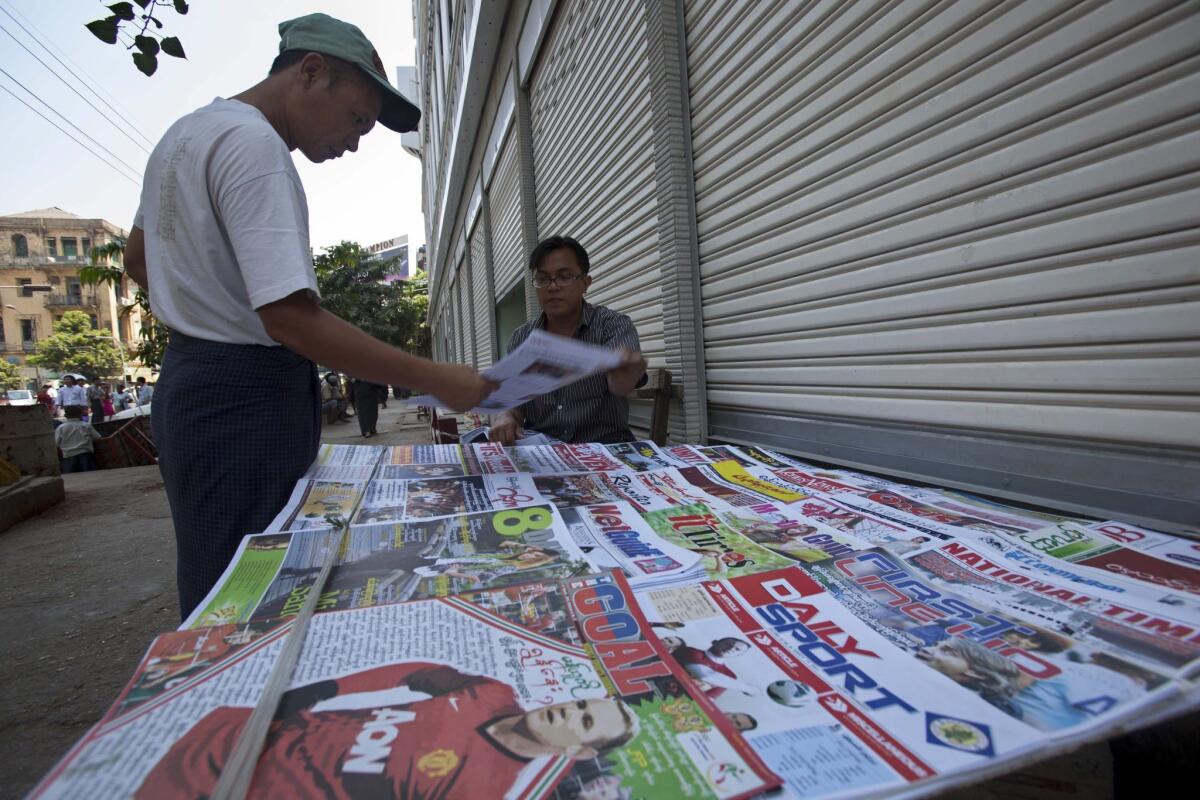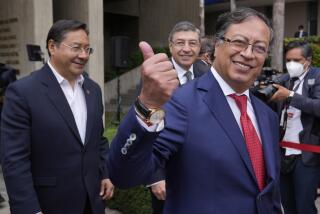Myanmar press freedom: Unprecedented but still subject to pressures

It was a scene wholly unimaginable just a few years ago when this country was under strict military rule and its press subject to overwhelming controls: The ballroom of one of this city’s fanciest hotels, filled with journalists from around the world, assembled for an international conference headlined “On the Path to a Free Media.”
Yet outside the venue where the delegates to the Austria-based International Press Institute had gathered Friday, a small group of local journalists was not celebrating. Instead, they were assembled in protest, handing out stickers saying, “Stop attacks on the Media!”
And that wasn’t all. During one of the first speeches of the day, a demonstrator interrupted Information Minister Ye Htut, silently holding up a sign as camera shutters clicked: “Stop beating, arresting and imprisoning journalists!”
The minister did his best to embrace the contradictions. “Five years ago, you couldn’t dream of IPI here; you could not dream of journalists openly protesting the government information minister,” he told the audience. This, he said, was “a good sign of how Myanmar is changing.”
Four years after Myanmar’s long-ruling junta was officially dissolved, a nominally civilian government was installed and strict censorship rules eased, the Southeast Asian country’s media scene has become vibrant and even feisty.
In a nation where privately run daily newspapers were outlawed until 2012, there are now 32 daily newspapers, 429 weekly journals and 347 monthly magazines, many started by long-exiled journalists who returned home at long last.
Thanks to such developments, Myanmar climbed seven spots on Reporters Without Borders’ annual World Press Freedom rankings last year, from No. 151 to No. 145 - rated as more free than countries including Malaysia, the Philippines, Singapore and Mexico.
But some say progress has stalled. Journalists are still arrested, imprisoned and intimidated. In a special issue timed to the media conference, the Mizzima Weekly magazine produced a package of stories headlined “Media Under Threat,” complete with a full-page chart chronicling 20 instances in which journalists have been jailed since 2013.
In one recent case, the editor-in-chief and a senior reporter for the Myanmar Post were sentenced to two months in prison for a defamation conviction after allegedly misquoting a member of parliament.
Reporters covering student protests in March were detained for days, and a freelance writer was held after sharing a satirical image on his Facebook page that mocked President U Thein Sein and some military leaders.
(And it’s not just reporters who complain about constraints on freedom of expression. A New Zealander who managed a Yangon bar was convicted this month of insulting religion after his pub circulated a promotional poster depicting a Buddha wearing large headphones.)
Soe Myint, who returned from exile in 2012 after 22 years and is now editor in chief of the Mizzima Media Group, said Myanmar was both “progressing and regressing” on a daily basis.
In the fall, Myanmar will hold national elections in which longtime dissident and Nobel laureate Aung San Suu Kyi’s National League for Democracy will participate – the first chance at a free and fair vote in more than 20 years.
Whether the government allows unfettered reporting in the runup to the vote could be a decisive factor both in the outcome and in how Myanmar is regarded by the international community.
“Myanmar is fast approaching a crucial test in our ongoing transition,” said Soe Myint. “Just how free and fair the election is deemed to be will greatly impact the social, political and investment climate in the country and significantly serve to stabilize or destabilize the reform process.”
In its 2014 index, Reporters Without Borders said Myanmar’s reform process could serve as a model for change in other Southeast Asian countries.
Myanmar, it said, is “being watched with great interest elsewhere, especially in neighboring countries such as Laos, where the situation of freedom of information has stagnated alarmingly, in Cambodia, in Singapore, where the authorities are on edge, and in Vietnam, still in the grip of authoritarian single-party rule.… Will [the country] become Southeast Asia’s benchmark for positive change in freedom of information? This remains to be seen.”
David Kaye, the U.N. special rapporteur on freedom of expression, said there has been a “remarkable depth of change” in Myanmar in recent years. But he also urged the government to immediately release all imprisoned journalists, saying it would be a significant gesture to demonstrate a commitment to protecting freedom of speech. In addition, he called on authorities to do more to ensure that reporters are not harassed and intimidated.
Ye Htut, the information minister, said it was not up to him to grant any amnesty to jailed reporters, and he acknowledged that changing attitudes within the government is not easy.
“Since 1962, all our laws were about how to control the media,” he said. Now, things have changed, but experience in how to engage with the media in a different way is lacking, and some officials have yet to fully adopt a new mindset.
“From the government side… [some officials] see the media as a threat, not as an opportunity to deliver their ideas or getting the feedback from the people,” he acknowledged. “But if we want to guarantee freedom of this country, we need to guarantee freedom of the media.”
julie.makinen@latimes.com
More to Read
Start your day right
Sign up for Essential California for news, features and recommendations from the L.A. Times and beyond in your inbox six days a week.
You may occasionally receive promotional content from the Los Angeles Times.







